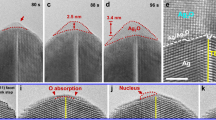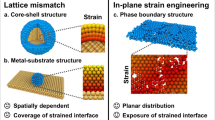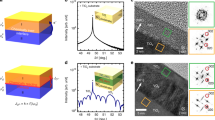Abstract
The oxides of platinum group metals are promising for future electronics and spintronics due to the delicate interplay of spin-orbit coupling and electron correlation energies. However, their synthesis as thin films remains challenging due to their low vapour pressures and low oxidation potentials. Here we show how epitaxial strain can be used as a control knob to enhance metal oxidation. Using Ir as an example, we demonstrate the use of epitaxial strain in engineering its oxidation chemistry, enabling phase-pure Ir or IrO2 films despite using identical growth conditions. The observations are explained using a density-functional-theory-based modified formation enthalpy framework, which highlights the important role of metal-substrate epitaxial strain in governing the oxide formation enthalpy. We also validate the generality of this principle by demonstrating epitaxial strain effect on Ru oxidation. The IrO2 films studied in our work further revealed quantum oscillations, attesting to the excellent film quality. The epitaxial strain approach we present could enable growth of oxide films of hard-to-oxidize elements using strain engineering.
This is a preview of subscription content, access via your institution
Access options
Access Nature and 54 other Nature Portfolio journals
Get Nature+, our best-value online-access subscription
$29.99 / 30 days
cancel any time
Subscribe to this journal
Receive 12 print issues and online access
$259.00 per year
only $21.58 per issue
Buy this article
- Purchase on Springer Link
- Instant access to full article PDF
Prices may be subject to local taxes which are calculated during checkout





Similar content being viewed by others
Data availability
The source data for the results of this work can be accessed using the given link: https://doi.org/10.13020/9wm7-x981. Any additional data related to this paper may be requested from the corresponding authors.
References
Novotny, Z. et al. Kinetics of the thermal oxidation of Ir(100) toward IrO2 studied by ambient-pressure X-ray photoelectron spectroscopy. J. Phys. Chem. Lett. 11, 3601–3607 (2020).
van Spronsen, M. A., Frenken, J. W. M. & Groot, I. M. N. Observing the oxidation of platinum. Nat. Commun. 8, 429 (2017).
Nunn, W. et al. Novel synthesis approach for “stubborn” metals and metal oxides. Proc. Natl Acad. Sci. USA 118, e2105713118 (2021).
Liu, X. R. et al. Synthesis and electronic properties of Ruddlesden–Popper strontium iridate epitaxial thin films stabilized by control of growth kinetics. Phys. Rev. Mater. 1, 075004 (2017).
Nair, H. P. et al. Demystifying the growth of superconducting Sr2RuO4 thin films. APL Mater. 6, 101108 (2018).
Nunn, W. et al. Solid-source metal-organic molecular beam epitaxy of epitaxial RuO2. APL Mater. 9, 091112 (2021).
Wakabayashi, Y. K. et al. Machine-learning-assisted thin-film growth: Bayesian optimization in molecular beam epitaxy of SrRuO3 thin films.APL Mater. 7, 101114 (2019).
Kim, B. J. et al. Phase-sensitive observation of a spin-orbital Mott state in Sr2IrO4. Science 323, 1329–1332 (2009).
Kim, W. J. et al. Strain engineering of the magnetic multipole moments and anomalous Hall effect in pyrochlore iridate thin films.Sci. Adv. 6, eabb1539 (2020).
Kim, Y. K., Sung, N. H., Denlinger, J. D. & Kim, B. J. Observation of a d-wave gap in electron-doped Sr2IrO4. Nat. Phys. 12, 37–41 (2016).
Kushwaha, P. et al. Nearly free electrons in a 5d delafossite oxide metal. Sci. Adv. 1, e1500692 (2015).
Nelson, J. N. et al. Interfacial charge transfer and persistent metallicity of ultrathin SrIrO3/SrRuO3 heterostructures. Sci. Adv. 8, eabj0481 (2022).
Zhu, Z. H. et al. Anomalous antiferromagnetism in metallic RuO2 determined by resonant X-ray scattering. Phys. Rev. Lett. 122, 017202 (2019).
Uchida, M. et al. Field-direction control of the type of charge carriers in nonsymmorphic IrO2. Phys. Rev. B 91, 241119 (2015).
Smejkal, L., Gonzalez-Hernandez, R., Jungwirth, T. & Sinova, J. Crystal time-reversal symmetry breaking and spontaneous Hall effect in collinear antiferromagnets. Sci. Adv. 6, eaaz8809 (2020).
Nelson, J. N. et al. Dirac nodal lines protected against spin-orbit interaction in IrO2. Phys. Rev. Mater. 3, 064205 (2019).
Ruf, J. P. et al. Strain-stabilized superconductivity. Nat. Commun. 12, 59 (2021).
Ellingham, H. J. T. Reducibility of oxides and sulphides in metallurgical processes. J. Soc. Chem. Ind. Trans. Commun. 63, 125–160 (1944).
Chambers, S. A. Epitaxial growth and properties of thin film oxides. Surf. Sci. Rep. 39, 105–180 (2000).
Prakash, A. et al. Hybrid molecular beam epitaxy for the growth of stoichiometric BaSnO3. J. Vac. Sci. Technol. A 33, 060608 (2015).
Schlom, D. G. Perspective: oxide molecular-beam epitaxy rocks!. APL Mater. 3, 062403 (2015).
Smith, E. H. et al. Exploiting kinetics and thermodynamics to grow phase-pure complex oxides by molecular-beam epitaxy under continuous codeposition. Phys. Rev. Mater. 1, 023403 (2017).
Song, J. H., Susaki, T. & Hwang, H. Y. Enhanced thermodynamic stability of epitaxial oxide thin films. Adv. Mater. 20, 2528–252 (2008).
Petrie, J. R. et al. Strain control of oxygen vacancies in epitaxial strontium cobaltite films. Adv. Funct. Mater. 26, 1564–1570 (2016).
Yun, H., Prakash, A., Birol, T., Jalan, B. & Mkhoyan, K. A. Dopant segregation inside and outside dislocation cores in perovskite BaSnO3 and reconstruction of the local atomic and electronic structures. Nano Lett. 21, 4357–4364 (2021).
Gorbenko, O. Y., Samoilenkov, S. V., Graboy, I. E. & Kaul, A. R. Epitaxial stabilization of oxides in thin films. Chem. Mater. 14, 4026–4043 (2002).
Truttmann, T. K., Liu, F. D., Garcia-Barriocanal, J., James, R. D. & Jalan, B. Strain relaxation via phase transformation in high-mobility SrSnO3 films. ACS Appl. Electron. Mater. 3, 1127–1132 (2021).
Bose, A. et al. Effects of anisotropic strain on spin-orbit torque produced by the Dirac nodal line semimetal IrO2. ACS Appl. Mater. Interfaces 12, 55411–55416 (2020).
Liu, J. et al. Strain-induced nonsymmorphic symmetry breaking and removal of Dirac semimetallic nodal line in an orthoperovskite iridate. Phys. Rev. B 93, 085118 (2016).
Hou, X., Takahashi, R., Yamamoto, T. & Lippmaa, M. Microstructure analysis of IrO2 thin films. J. Cryst. Growth 462, 24–28 (2017).
Stoerzinger, K. A., Qiao, L., Biegalski, M. D. & Shao-Horn, Y. Orientation-dependent oxygen evolution activities of rutile IrO2 and RuO2. J. Phys. Chem. Lett. 5, 1636–1641 (2014).
Abb, M. J. S., Herd, B. & Over, H. Template-assisted growth of ultrathin single-crystalline IrO2(110) films on RuO2(110)/Ru(0001) and its thermal stability. J. Phys. Chem. C 122, 14725–14732 (2018).
Wang, F. & Senthil, T. Twisted Hubbard model for Sr2IrO4: magnetism and possible high temperature superconductivity. Phys. Rev. Lett. 106, 136402 (2011).
Pesin, D. & Balents, L. Mott physics and band topology in materials with strong spin-orbit interaction. Nat. Phys. 6, 376–381 (2010).
Wan, X. G., Turner, A. M., Vishwanath, A. & Savrasov, S. Y. Topological semimetal and Fermi-arc surface states in the electronic structure of pyrochlore iridates. Phys. Rev. B 83, 205101 (2011).
Go, A., Witczak-Krempa, W., Jeon, G. S., Park, K. & Kim, Y. B. Correlation effects on 3D topological phases: from bulk to boundary. Phys. Rev. Lett. 109, 066401 (2012).
Guo, L. et al. Searching for a route to synthesize in situ epitaxial Pr2Ir2O7 thin films with thermodynamic methods. npj Comput. Mater. 7, 144 (2021).
Gutierrez-Llorente, A., Iglesias, L., Rodriguez-Gonzalez, B. & Rivadulla, F. Epitaxial stabilization of pulsed laser deposited Srn+1IrnO3n+1 thin films: entangled effect of growth dynamics and strain. APL Mater 6, 091101 (2018).
Butler, S. R. & Gillson, J. L. Crystal growth, electrical resistivity and lattice parameters of Ruo2 and Iro2. Mater. Res. Bull. 6, 81–88 (1971).
Sun, Y., Zhang, Y., Liu, C. X., Felser, C. & Yan, B. H. Dirac nodal lines and induced spin Hall effect in metallic rutile oxides. Phys. Rev. B 95, 235104 (2017).
Kawasaki, J. K. et al. Engineering carrier effective masses in ultrathin quantum wells of IrO2. Phys. Rev. Lett. 121, 176802 (2018).
Kawasaki, J. K. et al. Rutile IrO2/TiO2 superlattices: a hyperconnected analog to the Ruddlesden–Popper structure. Phys. Rev. Mater. 2, 054206 (2018).
Kawasaki, J. K., Uchida, M., Paik, H., Schlom, D. G. & Shen, K. M. Evolution of electronic correlations across the rutile, perovskite, and Ruddlesden-Popper iridates with octahedral connectivity. Phys. Rev. B 94, 121104 (2016).
Morozova, N. B., Semyannikov, P. P., Sysoev, S. V., Grankin, V. M. & Igumenov, I. K. Saturated vapor pressure of iridium(III) acetylacetonate. J. Therm. Anal. Calorim. 60, 489–495 (2000).
Freakley, S. J., Ruiz-Esquius, J. & Morgan, D. J. The X-ray photoelectron spectra of Ir, IrO2 and IrCl3 revisited. Surf. Interface Anal. 49, 794–799 (2017).
Hohenberg, P. & Kohn, W. Inhomogeneous electron gas. Phys. Rev. 136, 7 (1964).
Kohn, W. & Sham, L. J. Self-consistent equations including exchange and correlation effects. Phys. Rev. 140, A1133–A1138 (1965).
Kresse, G. & Hafner, J. Ab initio molecular dynamics for liquid metals. Phys. Rev. B 47, 558–561 (1993).
Kresse, G. & Hafner, J. Ab initio molecular-dynamics simulation of the liquid-metal–amorphous-semiconductor transition in germanium. Phys. Rev. B 49, 14251–14269 (1994).
Kresse, G. & Furthmüller, J. Efficiency of ab-initio total energy calculations for metals and semiconductors using a plane-wave basis set. Comput. Mater. Sci. 6, 15–50 (1996).
Acknowledgements
We thank N. Seaton for help with SEM, EDX and EBSD. Funding for film growth and characterization (S.N., D.L. and B.J.) was supported by the US Department of Energy through DE-SC0020211. S.N. and D.L. acknowledge support from the Air Force Office of Scientific Research (AFOSR) through grant numbers FA9550-21-1-0025 and FA9550-21-0460. S.G., Z.Y. and K.A.M. were supported partially by the UMN MRSEC program under award number DMR-2011401. S.G. and K.A.M. were also supported by SMART, one of seven centres of nCORE, a Semiconductor Research Corporation program, sponsored by the National Institute of Standards and Technology (NIST). Parts of this work were carried out at the Characterization Facility, University of Minnesota, which receives partial support from the National Science Foundation (NSF) through the MRSEC program under award number DMR-2011401. S.J. acknowledges support from the NSF under award number DMR-2129879. W.J. acknowledges support from the US Department of Energy (DOE) Office of Science under DE-SC0023478. R.B.C. acknowledges support from the AFOSR Young Investigator Program under FA9550-20-1-0034. A.J. and A.S. acknowledge support from the NSF through the UD-CHARM University of Delaware Materials Research Science and Engineering Center (number DMR-2011824). The first-principles calculations used Bridges-2 at PSC through allocation DMR150099 from the Advanced Cyberinfrastructure Coordination Ecosystem: Services & Support (ACCESS) program, which is supported by NSF grant numbers 2138259, 2138286, 2138307, 2137603 and 2138296, and the DARWIN computing system at the University of Delaware, which is supported by NSF grant number 1919839. This research used resources of the Center for Functional Nanomaterials and National Synchrotron Light Source II, which are US DOE Office of Science Facilities, at Brookhaven National Laboratory under contract number DE-SC0012704. This research used resources of the Advanced Photon Source, a DOE Office of Science user facility operated for the DOE Office of Science by Argonne National Laboratory under contract number DE-AC02-06CH11357.
Author information
Authors and Affiliations
Contributions
S.N. and B.J. conceived the idea and established proof of concept. S.N. grew films and characterized them using XRD, AFM, optical microscopy, SEM and electrical transport measurements. S.N. and B.J. analysed the data. Z.Y. performed magneto-transport measurements and data analysis. D.L. performed XPS measurements. S.G. performed STEM analysis under the supervision of K.A.M. LEEM, LEED and XPS were performed by J.T.S. and analysed by S.J., W.J. and R.B.C. Y.L. and H.Z. carried out synchrotron X-ray diffraction measurements and data analysis. DFT calculations were performed by A.S. under the supervision of A.J. S.N. and B.J. wrote the manuscript. All authors contributed to the discussion and preparation of the manuscript. B.J. directed and organized the different aspects of the project.
Corresponding authors
Ethics declarations
Competing interests
The authors declare no competing interests.
Peer review
Peer review information
Nature Nanotechnology thanks Scott Chambers, Guangwen Zhou and the other, anonymous, reviewer(s) for their contribution to the peer review of this work.
Additional information
Publisher’s note Springer Nature remains neutral with regard to jurisdictional claims in published maps and institutional affiliations.
Supplementary information
Supplementary Information
Supplementary Figs. 1–15 and refs. 1–4.
Rights and permissions
Springer Nature or its licensor (e.g. a society or other partner) holds exclusive rights to this article under a publishing agreement with the author(s) or other rightsholder(s); author self-archiving of the accepted manuscript version of this article is solely governed by the terms of such publishing agreement and applicable law.
About this article
Cite this article
Nair, S., Yang, Z., Lee, D. et al. Engineering metal oxidation using epitaxial strain. Nat. Nanotechnol. 18, 1005–1011 (2023). https://doi.org/10.1038/s41565-023-01397-0
Received:
Accepted:
Published:
Issue Date:
DOI: https://doi.org/10.1038/s41565-023-01397-0
This article is cited by
-
Mending cracks atom-by-atom in rutile TiO2 with electron beam radiolysis
Nature Communications (2023)



